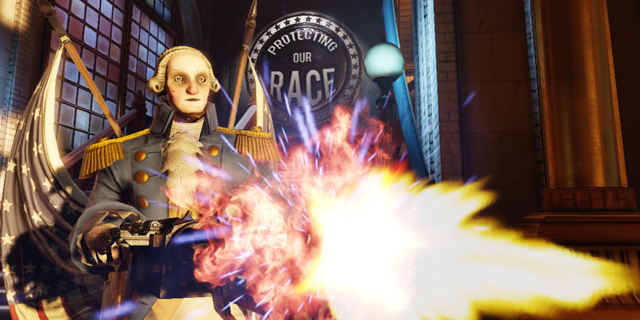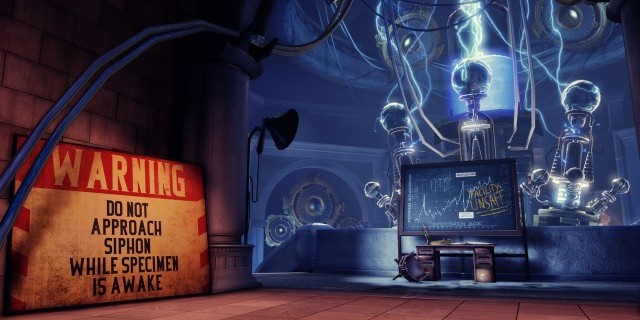
There are some games that have come along this console generation that will stand the test of time. They will be fondly remembered and analyzed for years to come, even with some flaws. The number of titles that meet this criteria are not large in number, but they come around just often enough and help people realize why they love games in the first place. The original BioShock is the perfect example of this, setting the groundwork for a potential franchise and becoming one of the most revered games in the past several years.
Irrational Games’ follow-up, BioShock Infinite, doesn’t just live up to that legend. It surpasses it.
Taking place in 1912, Infinite tells the tale of ex-Pinkerton agent Booker DeWitt, a man in debt and given a chance to wipe the slate clean. He journeys to the floating city of Columbia to rescue a young girl named Elizabeth from the clutches of the city’s leader, Zachary Hale Comstock, known by the citizens of Columbia as the Prophet. To avoid any potential spoilers, it’s best that you discover everything beyond those basics for yourself, as the plot is often exciting and full of just enough intrigue to keep you guessing up until the final moments. Just when you think you have things figured out, you’re thrown another curveball. The less you know going into the game, the better.

The main crux, both in terms of its story and its gameplay mechanics, is the relationship between Booker and Elizabeth. The simple act of giving Booker a voice, something that the previous two BioShock games were lacking, changes the story dynamically. It’s not just about hearing him react to things as they happen, it’s about his interactions with Elizabeth, who remains one of the liveliest and most well-written characters I’ve seen in a game in quite some time.
Dressed to kill
Throughout your journey through Columbia, you’ll come across a large number of equitable items of clothing that grant you different combat abilities. Some will increase your melee damage while others stun enemies nearby those you are targeting as you shoot them. It changes just enough about the game’s many encounters to feel important without becoming something you need to focus on.
It’s the combination of her animations, both during story moments and while you’re exploring Columbia, and Courtnee Draper’s excellent performance. She doesn’t just wait around for you to move on to where you need to go; she will actively examine (and interact with) the environment in ways that any person would do. She’ll often comment on things she’s seeing, find hidden objects for you or even help you complete some optional objectives that solve some of Columbia’s many secrets. In short, without Elizabeth, a lot of what makes the game so compelling simply wouldn’t work.
The main characters are fantastic and the side cast, ranging from the fanatical Comstock to his many enemies and allies, all stand out in a game that is full to the brim with personality. That being said, one of the best characters in the entire game is the city itself. You’ll have plenty of chances to explore in-between the game’s many intense fights, and these moments of respite are when you’ll begin to understand Columbia (and its people) the most.
As you explore the many districts of the floating city, you’ll discover the large number of themes that BioShock Infinite plays with, including racism, American exceptionalism, religion (and fanaticism) and many others. These are not leaned on as heavily as the science fiction tale at the center of Infinite, but they feel almost as important.

Like in the first two titles, you’ll find audio diaries (this time known as voxophones) scattered throughout Columbia that reveal details about the many characters as well as fill in some pieces about the city and themes mentioned above. You will miss a lot of these if you’re not careful, and many aren’t central to the story, but they fill in small gaps and expand upon the back story, making Columbia seem like a place that might almost have existed in our own world (if not for the whole “floating city” part, that is).
The city itself is dripping with atmosphere and a sense of place that you rarely see in games these days. Every building you walk into, every NPC you approach and every hidden area, they all add up to a city that feels alive. And those themes, the ones neatly tucked into every corner of Infinite’s already packed story, only help to flesh out themes that might otherwise feel tacked on because of the time period and nothing more. You could miss a lot of these small details if you rush through the game, but doing so robs you of one of the main strengths of Infinite’s world.
All this is fantastic, but how does it actually play? BioShock’s greatest strength never was its combat mechanics, despite the amazing variety of weapons and abilities. Infinite not only contains a stunning, well-realized story, but also intensely satisfying and always varied combat that perfectly complements the game’s narrative arc.

The two main tools at your disposal are your guns and your vigors. The vigors are like the plasmids from the previous games, granting Booker a wealth of various different abilities, including the power to throw fire and lightning attacks or knock enemies into the air for a few seconds to pick them off quickly. Not only that, but the vigors also have alternate functions, allowing you to use most of them to set traps you can lure your enemies into. Traps are never essential, but they felt more like a larger part of the combat than in the original game, making them a lot more accessible.
Your lock-picking friend
Elizabeth is not only handy in battle, she is also quite handy with a lock pick and can break into areas with hidden goods and other such secrets. You’ll find picks scattered throughout Columbia, motivating you to check every locked door or backtrack when given the opportunity. It’s a small touch, but one that’s implemented well and gives the player one less mechanic to worry about.
The guns all feel satisfying and weighty, and thanks to the selection of weapons at your disposal, you’ll always have a chance to experiment with different combinations. Integrating your guns and your vigors is a blast, allowing you to find different vigor combinations all while shooting your foes down with whatever gun you have equipped.
This is nothing new to those who have played BioShock before, but it all feels faster and more satisfying in Infinite thanks to the simplification of certain mechanics, such as having your melee weapon always ready to use with one button press, giving you ample opportunities to get a finishing blow when the time is right without jeopardizing you with the larger fight at hand.
The first vigor you get, the possession ability, allows you to take control various mounted guns (or, with an upgrade, human enemies). This replaces the monotonous hacking mini-game from the underwater variants of BioShock, making the act of taking control of your opponents’ weapons faster in order to keep the flow of combat at a great pace.

It isn’t long before you’re introduced to the skyline system, giving you the opportunity to glide along (and jump around) a series of rails and change your position on the fly. Staying in one place is never a good idea, so during the more open battles you’ll have a chance to take advantage of the skylines, glide to a better position (all while taking down a few baddies in the process), and get to higher ground in order to have the advantage. You can also jump off the skylines directly onto an enemy and use the skyhook (the device that allows you to traverse the skylines) as a gratifying melee weapon.
And since Elizabeth is with you for a majority of the game, she will provide some excellent support during battles. Her ability allows her to open “tears” in the world, which are essentially small openings to alternate dimensions, allowing you to create cover, weapons, new grapple points for your skyhook, or even bring in allies to help your cause. You can only have one tear open at a time, but you can swap between them as long as you have the one you want to switch to in sight. Not only is Elizabeth’s ability essential in combat, she will also regularly find and toss you ammo, health packs and salt bottles (which refills your vigor meter) to keep you stocked and in the battle.
All of this combines into some of the most rewarding combat scenarios in any shooter I’ve played. When approached with several groups of enemies, your options are almost limitless. For instance, you can use a vigor to launch one group of enemies into the air, have Elizabeth create a tear that brings out a gun turret to slowly take care of those guys. Meanwhile, you jump onto the skyline, glide along to a second group of enemies, use a vigor that shoots crows out of your hands to distract (and slowly damage) them, and then jump down to deliver some finishing blows. This all happens seamlessly and, with mastery of the mechanics, in quick succession. You will feel a sense of accomplishment that you rarely get from single-player shooters these days.
To top it all off, Infinite is gorgeous, with an art style that brings Columbia and its wild cast of characters to life in vivid detail. PC is the way to go, but even on aging console hardware, the game never fails to impress. The soundtrack, a mix of original music, licensed tracks, and new arrangements of classic songs, is brilliant. It feels era appropriate and augments the game’s many intense sequences with bombast. Even the little cues, including those that play when you perform a finishing blow on an enemy, add just the right amount of musical flair to the combat without feeling overbearing.
BioShock Infinite is a rare game that dares to challenge its audience with important (and controversial) themes that enhance the science fiction-fueled story in a genius, non-intrusive way. It’s a sequel that takes everything that works about the previous entries and molds them into something that feels distinct without compromising what made it so memorable in the first place. It’s a fast-paced thrill ride with plenty of exciting combat sequences and a handful of polished, well-executed mechanics and memorable story sequences. If there is any one title that will define this console generation, BioShock Infinite might just be that game.
Pros: Memorable characters, fleshed-out world, masterful gameplay mechanics, stunning visuals
Cons: You’ll have a difficult time thinking about anything else after the credits roll



















